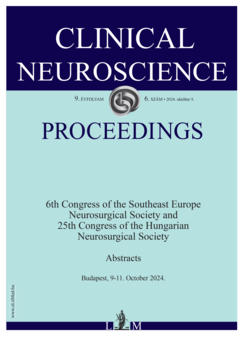Vertebral artery dissection during traumatic injury of the cervical spine, two case reports
OLÁH Csaba1, NAGY Dávid1, DEMETER Béla1
2024. OKTÓBER 09.
Ideggyógyászati Szemle Proceedings - 2024;9(6)
OLÁH Csaba1, NAGY Dávid1, DEMETER Béla1
2024. OKTÓBER 09.
Ideggyógyászati Szemle Proceedings - 2024;9(6)
Szöveg nagyítása:

Vertebral artery dissection during traumatic injury of the cervical spine, two case reports.
Introduction: If severe cervical spinal cord injury or severe cervical vertebral fracture, subluxation or luxation is confirmed, 20-40% have vertebral artery dissection or occlusion. These can be asymptomatic, but can cause ad- ditional neurological damage in addition to cervical my- elon and cervical nerve root symptoms.
Aims: Vertebral artery dissection can be caused by direct injuries, stab wounds or gunshot wounds. Indirect vertebral artery dissection can occur at the same time as subluxation, luxation, or complex fractures of the cervical vertebra. CTA is the examination procedure of choice. In many cases, DSA examination and, if necessary, neuroin- terventional treatment must precede open neurosurgery. Methods: Our first patient, a 52-year-old male patient, drifted off the highway at high speed as the driver of a car.Complete luxation of a C.VI vertebra caused uni- lateral vertebral artery 2-segment dissection-occlusion. Before cervical spine surgery, a 12 kg pull was applied under a DSA image intensifier, as a result of which the arch of the cervical spine and the luxated C.VI. his ver- tebra returned to its original position before the luxation. Before surgery, the dissected vertebral artery was closed during endovascular intervention. In the second case, our 67-year-old male patient was stabbed in the neck with a long screwdriver from behind by his own son after a fight at home. CT examination shows the tip of the screwdriver in between the vertebrae C.IV-V. passing through the left vertebral canal. The patient had no neurological symp- toms. In both of our cases, parent vessel occlusion was performed at the level of the vertebral artery injury before the neurosurgical operation.
Result: After occlusion of the vertebral artery, neuro- surgery procedures could be performed safely in both pa- tients. We did not detect any bleeding from the vertebral artery in any of his operations.
Conclusion: If the dissection of the vertebral artery does not cause neurological loss and is not complete, then the occlusion must
Ideggyógyászati Szemle Proceedings
Despite evidence based institutional protocols being in place in many countries, aneurysmal subarachnoid hemorrhage (SAH) continues to be a major socio-economic burden with many open questions remaining regarding the optimal management of the affected patients.
Ideggyógyászati Szemle Proceedings
Arteriovenous malformation (AVM) is an anomaly of blood vessel formation. Numerous models have been established to understand the nature of AVM.
Ideggyógyászati Szemle Proceedings
Additive manufacturing has gained significant traction in industrial applications due to its high potential when it comes to manufacturing objects with complex geometry.
Ideggyógyászati Szemle Proceedings
Not only other surgical and robotic fields, but minimally invasive procedures in spine surgery have undergone significant development in recent times. A demand emerged from both surgeons and patients to develop and perform these types of surgeries in order to prevent biomechanical and surgical complications.
Ideggyógyászati Szemle Proceedings
Functional magnetic resonance imaging (fMRI) is crucial for presurgical language mapping in neurosurgery, helping identify eloquent brain regions to preserve during operations. Effective language mapping depends on advanced fMRI acquisition and detailed data analysis to ensure accurate clinical outcomes.
Hypertonia és Nephrologia
A szerző nemzetközi és hazai adatok alapján bemutatja a krónikus vesebetegek számának dinamikus növekedését, és a végállapotú vesebetegek ellátásának növekvő terheit (vesepótló kezelések, hospitalizáció, magas halálozási kockázat – amely utóbbiak jelentős egészségügyi költségnövekedéssel járnak). Fontosnak tartja a betegség korai diagnózisát és adekvát konzervatív kezelését.
Hypertonia és Nephrologia
Elment, itt hagyott minket a magyar nefrológia 93 éves doyenje, prof. dr. Radó János, de gazdag öröksége velünk él tovább.
Ideggyógyászati Szemle Proceedings
Despite evidence based institutional protocols being in place in many countries, aneurysmal subarachnoid hemorrhage (SAH) continues to be a major socio-economic burden with many open questions remaining regarding the optimal management of the affected patients.
Ideggyógyászati Szemle Proceedings
Arteriovenous malformation (AVM) is an anomaly of blood vessel formation. Numerous models have been established to understand the nature of AVM.
Ideggyógyászati Szemle Proceedings
Additive manufacturing has gained significant traction in industrial applications due to its high potential when it comes to manufacturing objects with complex geometry.
Novel visualization of skull base surgical approaches based on human cadaver
Nyaki porckorong-betegséghez társuló nyaki syringomyelia
1.
2.
3.
4.
5.
Egészségpolitika
Hadiállapotként kezeli és így is reagál a kormány az egészségügy „rendezésére”1.
2.
3.
4.
5.